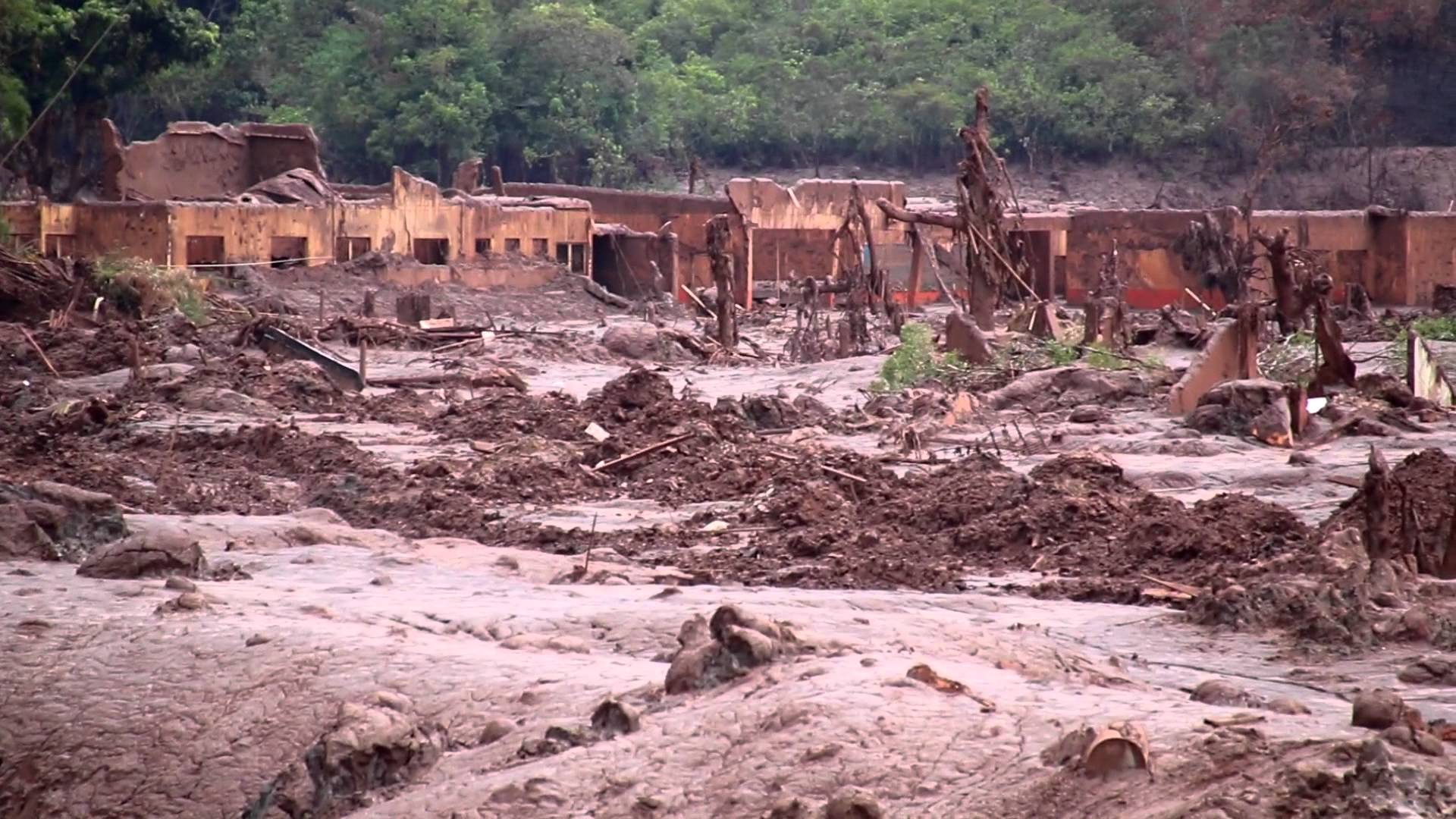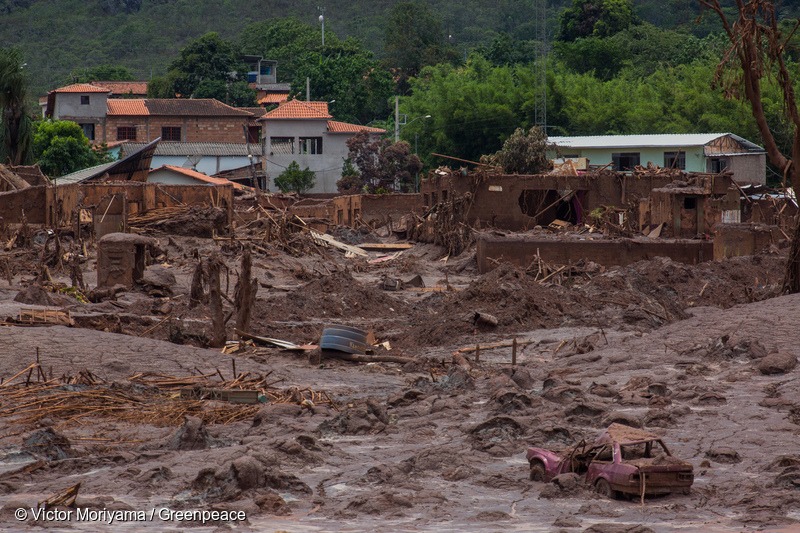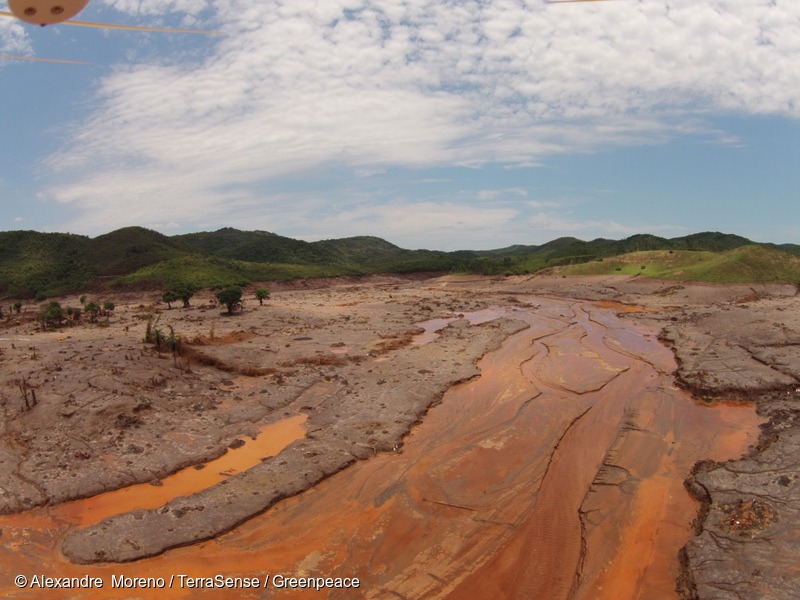On Thursday, November 5th, two dams holding millions of cubic meters of mining waste gave way – launching one of the worst environmental disasters in Brazilian history.

Vista geral do distrito Bento Rodrigues, da cidade de Mariana em Minas Gerais. No dia 5 de novembro, uma barragem de rejeitos minerais da empresa Samarco (controlada pela Vale e pela anglo-australiana BHP) estourou, inundando de lama tóxica a região. Bombeiros e defesa civil interromperam os trabalhos de busca devido ao perigo de um novo rompimento na barragem Germano. Acredita-se que 80% da cidade foi destruída. Mariana-MG. 14 de novembro de 2014. Foto: Victor Moriyama / Greenpeace.|Overview captured by drone in the district of Bento Rodrigues, in Mariana, Minas Gerais state, which was hit by the collapsing of a dam belonging to Samarco mining company, on November 5th. According to locals, around 80% of the city is now destroyed by the toxic mud, and all that is left is wreckage. The firefighters and the civil defense stopped searching for survivors. It is possible to see animals, like dogs and chickens, wandering through the toxic mud.
Drone captura vista geral do distrito de Bento Rodrigues, na cidade de Mariana, Minas Gerais, que foi atingido pelo rompimento da barragem da mineradora Samarco no dia 5 de novembro. Segundo moradores, cerca de 80% da cidade foi devastada pela força da lama tóxica, e o que resta agora são destroços. As buscas do Corpo de Bombeiros e da Defesa Civil foram suspensas. É possível ver animais vagando pelos montes de lama tóxica, como cachorros e galinhas. Mariana-MG. 14 de novembro de 2015. Foto: Alexandre Moreno / TerraSense / Greenpeace.
Over 25,000 Olympic swimming pools worth of mud – full of dangerous metals like manganese and mercury – quickly overtook the nearby mining community of Mariana in Minas Gerais state. At least seventeen people were killed. Hundreds more have been displaced by the wall of sludge released in the dam collapse.

A view of the district of Bento Rodrigues, in Mariana, Minas Gerais state. On November 5th, a dam containing mineral waste from Samarco (a Brazilian mining company controlled by Vale and British-Australian BHP) collapsed, flooding the region with toxic mud. The firefighters and the civil defense stopped the search for survivors due to the risk of a new disruption in the Germano Dam. It is believed that around 80% of the city has been destroyed.
Vista geral do distrito Bento Rodrigues, da cidade de Mariana em Minas Gerais. No dia 5 de novembro, uma barragem de rejeitos minerais da empresa Samarco (controlada pela Vale e pela anglo-australiana BHP) estourou, inundando de lama tóxica a região. Bombeiros e defesa civil interromperam os trabalhos de busca devido ao perigo de um novo rompimento na barragem Germano. Acredita-se que 80% da cidade foi destruída. Mariana-MG. 14 de novembro de 2014. Foto: Victor Moriyama / Greenpeace.
The mud surged through rural communities and into the Rio Doce, the major river in southeast Brazil. Since November 5th, it has been slowly working its way downstream — contaminating the drinking water of hundreds of thousands of people and turning protected forest and habitat into a desert of mud. The tragedy will continue to spread over 500 kilometers as contaminants from the sludge make their way towards the Atlantic coast, eventually endangering the Abrolhos National Marine Park.
Who is responsible?
Since the disaster, Greenpeace Brazil has been working alongside local organisations to monitor the damage and demand a complete and independent investigation over the disaster’s cause, as well the immediate financial compensation to the victims so they can try to put their lives back together.
The mining company in charge of the dam, Samarco (controlled by Vale and Anglo-Australian BHP Billiton), has acted irresponsibly in the face of this tragedy. There was no contingency plan for a situation like this, and at-risk communities were never prepared for a disaster of this magnitude. So far these companies have been fined one billion Brazilian reais (US$261 million), but this doesn’t begin to cover the costs of the disaster.
Meanwhile, authorities in Minas Gerais state continue to cater to corporate interests over the public good. The operational license for the dam that collapsed was not recommended because of risk of destabilisation. Yet this year the government of Minas Gerais has proposed new legislation to accelerate environmental licenses for the mining sector. The state already has more than 700 waste dams, but only four public employees to monitor them.

Overview captured by drone in the district of Bento Rodrigues, in Mariana, Minas Gerais state, which was hit by the collapsing of a dam belonging to Samarco mining company, on November 5th. According to locals, around 80% of the city is now destroyed by the toxic mud, and all that is left is wreckage. The firefighters and the civil defense stopped searching for survivors. It is possible to see animals, like dogs and chickens, wandering through the toxic mud.
Drone captura vista geral do distrito de Bento Rodrigues, na cidade de Mariana, Minas Gerais, que foi atingido pelo rompimento da barragem da mineradora Samarco no dia 5 de novembro. Segundo moradores, cerca de 80% da cidade foi devastada pela força da lama tóxica, e o que resta agora são destroços. As buscas do Corpo de Bombeiros e da Defesa Civil foram suspensas. É possível ver animais vagando pelos montes de lama tóxica, como cachorros e galinhas. Mariana-MG. 14 de novembro de 2015. Foto: Alexandre Moreno / TerraSense / Greenpeace.
What now?
Over last few days, Greenpeace Brazil has been documenting and investigating the path of destruction caused by the Samarco dam rupture: listening to people’s stories and docementinging the devastation. And Greenpeace teams will continue to monitor and document as the mud’s contaminants make their way to the ocean.
Thousands of lives are being radically affected – fishermen, ranchers, city-dwellers and the Krenak Indigenous people. The environment between Minas Gerais and Espírito Santo states suffers immeasurably. There is no time to lose in supporting the victims, investigating and punishing those responsible for this tragedy and in minimizing the effects on the environment.
Stand in solidarity with the people affected by this terrible tragedy. Share their story to pressure those responsible. And visit here (site in Portuguese) for more ways to help.
Bruno Weis is the Communications Coordinator of Greenpeace Brasil.


